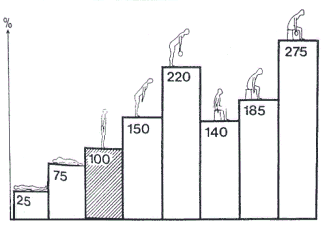
Sitting may seem innocuous, but did you know it is the cause of a huge number of cases of low back pain.
When you look at the pressures that are put through your back when you sit, you start to see why it can lead to back pain in so many people.
The disc of the lower back is like a cushion between the vertebrae. It is a fibrous disc with a soft centre that allows the disc to absorb shock and give free motion to the spine. If the disc is put under ongoing strain, it can become injured or dehydrated, and it can rupture and prolapse – the “slipped disc”.

This diagram show how the pressures in our discs are effected by our body position and posture. You can see how the pressure on the back is least when we lie down, but highest when we sit in a slumped position. In fact, any sitting at all has a much higher disc pressure than standing. And when these pressures are applied over an 8 hour work day, week after week, the results can be very damaging.
5 Ways to Beat Back Pain when you Sit
Posture posture posture!! Get your posture right from the start. From the diagram of disc pressure above, you can see how a slouched posture drastically raises disc pressure, and becomes a real injury risk. So make sure you know how to sit. Slide your bottom right back into your chair. Adjust your seat height so your feet rest flat on the floor. Ensure you have back support just above your waist. This helps maintain the natural curves in your back.
Set up your desk. If you are using a keyboard, ensure your keyboard is just below elbow height so your elbows are not bent more than 90 degrees. The upper edge of your screen should be at eye height.
Move at your desk. Moving ensures your disc pressure does not continually rise, and ensures good circulation in the muscles of the back and buttock. So even though you should start the day in the ideal posture, you should have other options to use throughout the day. Stand up for your telephone calls, schedule walking meetings to keep you moving, sit forward on the edge of your chair with your back upright for 5 minutes. This reduces the disc pressure caused by continual sitting.
Take breaks. If you can take 5 minutes break away from your chair every hour, your back will be healthier, your circulation will improve, you also reduce your risk of heart disease, and reduce risk of puffy ankles. Your attention span and concentration will also be improved.
Simple exercises in the office. There are a number of ways you can reduce the build up of disc pressure and keep your back healthy while you are still at work. Try these simple exercises every day.
Pelvic rocking. Sit up tall on the front edge of your chair, roll your pelvis so your body weight is resting on your thighs and sit bones, then gently roll your pelvis back to sit on your tail bone. You will notice your low back moves in and out of an arched position. Repeat this gentle rocking exercise several times every hour, then return to your good sitting poture.
Back extension. Stand, place both hands in the small of your back. Carefully bend backwards. Your hands will support the movement. Hold for 3 seconds and then return to an upright position.
Buttock clenches. As you sit, clench and relax your buttock muscles 10 times (no one needs to know you are doing it!) This will improve circulation through your lower back and gluteals, and improve your gluts ability to support your back.
SO be pro-active with your back health. Even if you are stuck at your desk all day, follow these simpe steps and you canl keep your back healthy and painfree.
Sarah Morton – Chartered Physiotherapist

